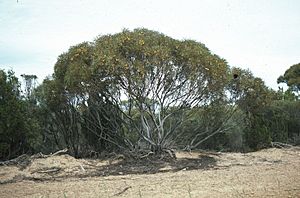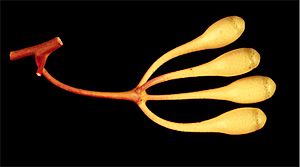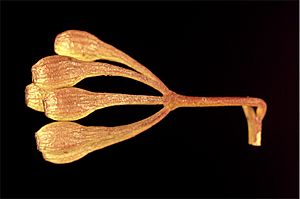Lake King mallee facts for kids
Quick facts for kids Lake King mallee |
|
|---|---|
 |
|
| Eucalyptus deflexa near Lake King | |
| Conservation status | |
| Scientific classification | |
| Genus: |
Eucalyptus
|
| Species: |
deflexa
|
The Eucalyptus deflexa, often called the Lake King mallee, is a special kind of mallee tree. It grows only in Western Australia. This plant has smooth bark that can be grey or whitish. Its adult leaves are usually long and narrow or slightly curved. You can spot its flower buds hanging down in groups of seven. When it blooms, it has cream-coloured or pink flowers. After flowering, it produces barrel-shaped fruits that also hang downwards.
Contents
What the Lake King Mallee Looks Like
The Lake King mallee is a type of mallee, which means it's a small tree or shrub with many stems growing from the ground. It usually grows to be about 1 to 3 meters (3 to 10 feet) tall. It has smooth bark that can be grey or whitish. This plant also has a special woody swelling at its base called a lignotuber. This helps it regrow after fires.
Its adult leaves are long and narrow, or sometimes slightly oval or curved. They are about 50 to 75 millimeters (2 to 3 inches) long and 9 to 11 millimeters (about 0.4 inches) wide. These leaves grow on a short stem called a petiole, which is about 5 to 12 millimeters (0.2 to 0.5 inches) long.
Flowers and Fruit
The flower buds grow in groups of seven. They hang down from a stalk called a peduncle, which is 10 to 30 millimeters (0.4 to 1.2 inches) long. Each individual bud sits on a smaller stalk called a pedicel, about 6 to 18 millimeters (0.2 to 0.7 inches) long.
When the buds are ready, they are creamy white and shaped like a cylinder. They are about 8 to 12 millimeters (0.3 to 0.5 inches) long and 4 to 5 millimeters (0.16 to 0.2 inches) wide. The top part of the bud, called the operculum (like a little cap), is cone-shaped or rounded. It's much shorter than the main part of the bud.
The Lake King mallee flowers between March and November. Its flowers are usually creamy white, but sometimes they can be pink. After the flowers, the plant produces woody, barrel-shaped fruits. These fruits also hang down and are about 9 to 12 millimeters (0.35 to 0.5 inches) long and 7 to 9 millimeters (0.28 to 0.35 inches) wide. The parts that release the seeds are hidden inside the fruit.
How It Got Its Name
The Eucalyptus deflexa was first officially described in 1976 by a scientist named Ian Brooker. He found a sample of the plant about 35 kilometers (22 miles) east of Lake King. His description was published in a science journal called Nuytsia.
The second part of its scientific name, deflexa, means "bent downwards" or "deflected." This refers to how its flowers hang down.
Where the Lake King Mallee Lives
The Lake King mallee grows in areas with low, bushy plants called shrubland. It likes flat areas or slightly raised ground. You can find it north and north-east of Lake King in Western Australia. These areas are part of what scientists call the Coolgardie and Mallee biogeographic regions.
Protecting the Lake King Mallee
The Government of Western Australia's Department of Parks and Wildlife has given this eucalypt a special classification: "Priority Four." This means the Lake King mallee is rare or almost threatened. It's important to protect these plants so they can continue to grow in the wild.




